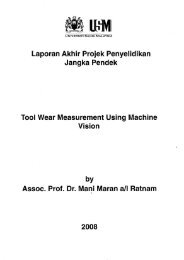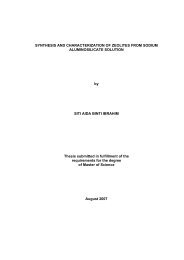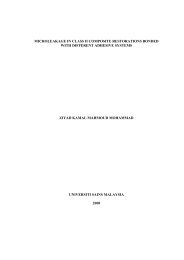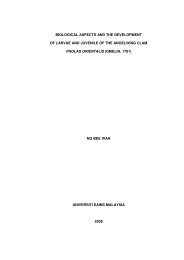a study on the performance of limestone roughing filter - ePrints@USM
a study on the performance of limestone roughing filter - ePrints@USM
a study on the performance of limestone roughing filter - ePrints@USM
You also want an ePaper? Increase the reach of your titles
YUMPU automatically turns print PDFs into web optimized ePapers that Google loves.
The slow sand <strong>filter</strong>s c<strong>on</strong>structed in rural communities show that many <strong>of</strong> <strong>the</strong>se <strong>filter</strong>s<br />
have short <strong>filter</strong> run and produce turbidity in <strong>the</strong> excess <strong>of</strong> <strong>the</strong> WHO guideline values<br />
for drinking water (Ali, 1998). Reliable operati<strong>on</strong> for sand filtrati<strong>on</strong> is possible when <strong>the</strong><br />
raw water has low turbidity and low suspended solids (Graham, 1988). For this reas<strong>on</strong>,<br />
when surface waters are highly turbid, ordinary sand <strong>filter</strong>s could not be used<br />
effectively. Therefore, <strong>the</strong> <strong>roughing</strong> <strong>filter</strong>s are used as pretreatment systems prior to<br />
sand filtrati<strong>on</strong> (Jayalath and Padmasiri, 1996). Fur<strong>the</strong>rmore, <strong>roughing</strong> <strong>filter</strong>s could<br />
reduce organic matters from wastewater. Therefore, <strong>roughing</strong> <strong>filter</strong>s can be used to<br />
polish wastewater before it is discharged to <strong>the</strong> envir<strong>on</strong>ment.<br />
Although <strong>roughing</strong> filtrati<strong>on</strong> technology is used as pretreatment to remove<br />
turbidity and followed by slow sand filtrati<strong>on</strong>, it may be used without slow sand filtrati<strong>on</strong><br />
if raw water originates from well protected catchment and if it is free from<br />
bacteriological c<strong>on</strong>taminati<strong>on</strong> (Wegelin, 1996). Roughing <strong>filter</strong>s make natural<br />
purificati<strong>on</strong> processes and no chemicals are necessary. Besides <strong>the</strong>se <strong>filter</strong>s could be<br />
built from local materials and manpower. These <strong>filter</strong>s will work a l<strong>on</strong>g time without<br />
maintenance (Wegelin, 1986). Therefore, <strong>roughing</strong> <strong>filter</strong>s are appropriate and<br />
ec<strong>on</strong>omical for rural water supply schemes.<br />
1.2 Research Objectives<br />
The main objective <strong>of</strong> this research is to <str<strong>on</strong>g>study</str<strong>on</strong>g> and evaluate <strong>the</strong> removal <strong>of</strong><br />
turbidity, suspended solids, biochemical oxygen demand and coliform organisms from<br />
wastewater using limest<strong>on</strong>e <strong>roughing</strong> <strong>filter</strong>. This <str<strong>on</strong>g>study</str<strong>on</strong>g> also tried to relate between flow<br />
rate and removal efficiencies. Fur<strong>the</strong>rmore, this research also studies <strong>on</strong> <strong>the</strong><br />
improvement ability <strong>of</strong> <strong>the</strong> <strong>filter</strong> due to ripening.<br />
2

















